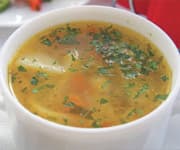Life Extension Magazine®
More Than A Decorative Garnish
If you think of parsley as only a decorative garnish that pretties up a plate, think again. This member of the carrot family is an undeniable superfood. Parsley (Petroselinum sativum)1 is a low-sodium, low-calorie, and fat-free food that contains two different kinds of potent compounds: volatile oil components and novel flavonoids. The activity of these volatile oils neutralizes particular types of carcinogens and qualifies parsley as a “chemoprotective” food—one that protects healthy tissues from the toxic effects of anticancer drugs.1
As you’ll learn in this article, parsley is much more than a garnish: It’s a compellingly nutritious, healing food that should become a part of your regular diet.
Powerful Compounds In Parsley
Novel substances known as volatile oils provide parsley with impressive health benefits. Volatile oils are compounds that deliver strong bioactive effects in extremely small doses. Parsley boasts highly active volatile components such as myristicin, apiol, eugenol, and more.
These volatile oil components, especially myristicin, appear to inhibit the formation of cancerous tumors, particularly lung tumors. Myristicin helps prevent oxidative damage by activating an enzyme called glutathione-S-transferase (GST). GST enables the detoxification of oxidized molecules via the body’s natural production of the molecule glutathione. Studies reveal myristicin also provides beneficial anti-inflammatory and antibacterial properties.1,2
Eugenol, another volatile oil component of parsley, is an effective antibacterial and antimicrobial agent. It may help control undesirable bacteria in the digestive system, including Candida overgrowth, and can be used as an anesthetic and antiseptic for tooth and gum diseases. Most exciting, eugenol has been shown to help reduce blood sugar levels and offers promise as a possible future treatment for diabetes.2-4
Parsley’s volatile oils can also help neutralize certain types of carcinogens, such as benzopyrenes, which are the toxic chemicals found in smoke from cigarettes and charcoal grilled foods.1,5
Parsley provides another class of powerful compounds: flavonoids. These compounds help protect cells against damage from oxygen-free radicals. Luteolin, a specific flavonoid, supports the metabolism of carbohydrates and provides anti-inflammatory activity. In animal studies, parsley extracts have been shown to raise the free-radical quenching capacity of the blood.1,6,7
Parsley’s Other Benefits

In addition to its volatile oils and flavonoids, parsley contains small amounts of protective compounds such as zeaxanthin, lutein, and cryptoxanthin.
At larger therapeutic doses, the ultraviolet light-filtering activity of zeaxanthin is known to help prevent age-related macular degeneration (AMD). Zeaxanthin and lutein protect against cataracts and promote healthy vision.2,3
Chlorophyll—the green pigment found in plants that allows them to convert sunlight to energy—is extremely abundant in parsley. Some sources suggest that chlorophyll works with the flavonoids in parsley to help enhance cellular formation of an immune-boosting molecule.8
It has long been reported that parsley has diuretic properties. A 2002 animal study demonstrated that parsley components raise urinary output. This diuretic activity can inhibit edema and may result in improved blood pressure and enhanced kidney function.9
How To Add Parsley To Your Diet

Because many people have come to view this superfood as decorative rather than edible, it is important to look at ways to incorporate parsley into your diet.
There are three parsley types: curly leaf parsley (P. crispum crispum), flat-leaf or Italian parsley (P. crispum neopolitanum), and the less familiar parsley root or Hamburg parsley (P. crispum tuberosum). All three pack a nutritional wallop.
While parsley may be low in sodium, calories, and fat, it’s full of vibrant, fresh taste. As a result, it can be used as a major ingredient in roasted vegetables, rice, pasta, and salad dishes. Parsley is a main constituent of tabbouleh, a Middle Eastern salad made of bulgur wheat and tomatoes.
It can also be chopped and added to hummus, ground meat, soups, omelets, and sauces. And of course, after you’ve learned to boost your nutrition profile by incorporating a lot more parsley into your daily diet, you can always add a sprig to the side of your plate!
Summary

While many people view parsley simply as a garnish, this low-calorie, low-sodium superfood contains two potent groups of nutrients: volatile oil components and flavonoids, both of which deliver strong health benefits. Increasingly savvy individuals are recognizing parsley as a nutrition powerhouse, and are adding it to their main dishes while reaping powerful health rewards.
If you have any questions on the scientific content of this article, please call a Life Extension® Health Advisor at 1-866-864-3027.
References
Available at: http://www.whfoods.com/genpage.php?tname=foodspice&dbid=100.Accessed December 3, 2014.
Available at: http://superfoodprofiles.com/parsley-nutrition. Accessed December 3, 2014.
Available at: http://www.nutrition-and-you.com/parsley.html. Accessed December 3, 2014.
Srinivasan S, Sathish G, Jayanthi M, et al. Ameliorating effect of eugenol on hyperglycemia by attenuating the key enzymes of glucose metabolism in streptozotocin-induced diabetic rats. Mol Cell Biochem. 2014 Jan;385(1-2):159-68.
Zheng GQ, Kenney PM, Zhang J, Lam LK. Inhibition of benzo[a]pyrene-induced tumorigenesis by myristicin, a volatile aroma constituent of parsley leaf oil.Carcinogenesis . 1992 Oct;13(10):1921-3.
Available at: http://www.healthdiaries.com/eatthis/6-health-benefits-of-parsley.html. Accessed December 3, 2014.
Popovi M, Kaurinovi B, Jakovljevi V, et al. Effect of parsley (Petroselinum crispum (Mill.) Nym. ex A.W. Hill, Apiaceae) extracts on some biochemical parameters of oxidative stress in mice treated with CCl(4). Phytother Res. 2007 Aug;21(8):717-23.
Available at: http://www.worldwellnesseducation.org/garnish-super-food. Accessed December 3, 2014.
Kreydiyyeh SI, Usta J. Diuretic effect and mechanism of action of parsley. J Ethnopharmacol. 2002 Mar;79(3):353-7.

